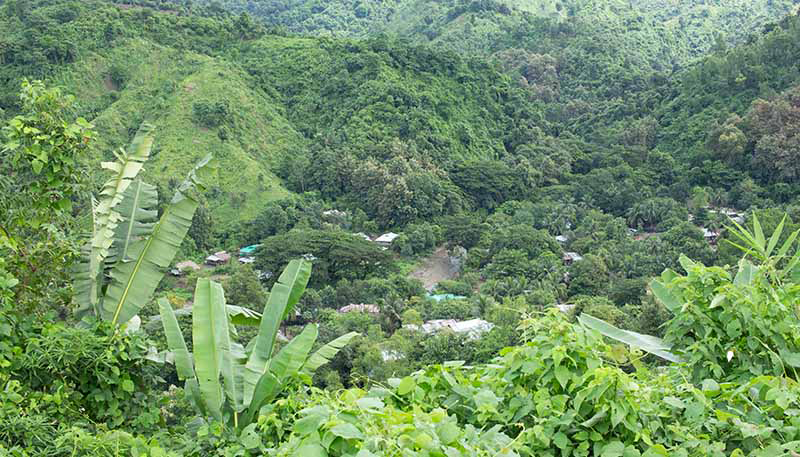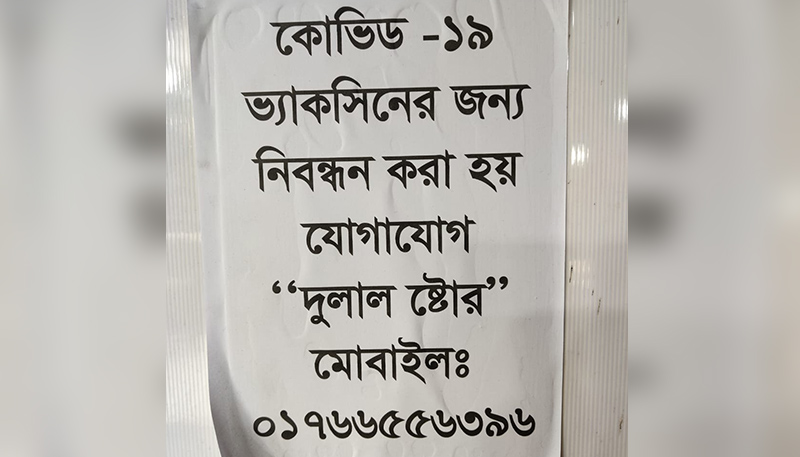
Covid-19 vaccination is voluntary in Bangladesh but a lack of awareness campaigns, complex online registration system, and pandemic-induced economic shock have left a vast portion of the vulnerable indigenous communities without any choice.
Although the government health agency, the Directorate General of Health Services (DGHS), provides the overall number of vaccine registration and the vaccinated people, it does not have any specific data on the indigenous communities who make up 1-2 per cent of the total population of 170 million.
Bangladesh reported its first coronavirus cases on March 8 last year and the first fatality 10 days later. Until October 28 this year, the country confirmed 1,568,857 cases and 27,847 deaths.
A large part of the indigenous communities is poor, living from hand to mouth. With the virus outbreak and subsequent containment measures like months-long lockdown straining people's pockets, spending a minimum of Tk 100 (USD 1.17) to go to the vaccination centres is tough for them.
An estimated 50 indigenous and tribal communities are found in Bangladesh with many of them concentrated in the Chittagong Hill Tracts (CHT) and others spread across the plain land. Poverty among these groups is much higher than the overall extent in the country. In the plains, extreme poverty is very high among the Santal, Oraon and the Kuch. A 2018 International Labour Organisation (ILO) and Bangladesh Institute of Development Studies study reported that 58.6 per cent of all indigenous and tribal people live on less than $1.25 per day compared to a national average of 24.8 per cent.
.png)
Last year, a report commissioned by Kapaeeng Foundation, a human rights organisation, and ILO put the poverty rate among these groups at above 80 per cent in the plains and 65 per cent in the CHT, much higher than the national average of 20.5 per cent.
The pandemic has worsened these communities' economic situations, leaving many of them jobless and struggling to make ends meet. Only a small part of the indigenous communities live in towns and the rest are scattered, mainly residing in remote areas. Although economic activities are resuming as the virus situation improves, the circumstances in hard-to-reach areas, particularly those inhabited by the indigenous communities, has not changed much. The remote areas are hardly inhabited by Bengalis.
Mong Nu Marma, a headman from Bandarban's Naikhongchhari near the Myanmar border, said many people have to spend a day and at least Tk 200 to reach the Union Sadar depending on where they live to receive the vaccine.
"It's one of the main reasons for vaccine reluctance," he said. The situation is more or less the same in rural areas outside the upazila and union centres.
National vaccination status
Bangladesh launched its countrywide vaccination campaign on February 7 this year with vaccines procured from India. The country is receiving vaccines under the COVAX facility and buying doses from other sources as well.
On April 25, the government suspended the first dose campaign after India stopped exporting the vaccine. Vaccine shortage forced the government to suspend registration on May 5 before resuming it two months later.
So far, 57,308,958 people have registered for vaccination and 41,268,810 people have got their first shots, while 21,332,289 were administered the second doses till October 27, according to the health ministry. Bangladesh kicked off its mass vaccination drive on August 7.
.png)
The country has so far approved AstraZeneca, Sinopharm, Sinovac, Moderna, Pfizer, Sputnik V, and Johnson and Johnson vaccines.
The government plans to inoculate 80 per cent of the country’s population. Earlier in October, Health Minister Zahid Maleque said the government was working to inoculate at least 50 per cent of the population by December and 70-80 per cent (117,856,000) by March next year.
On October 29, Bloomberg’s vaccine tracker showed 12.4 per cent of Bangladesh’s population was fully vaccinated. Until October 27, data compiled by Nikkei Asia showed Bangladesh had 60,871,683 vaccine doses or 37 per hundred people.
In a bid to reach more people, DGHS Director General Dr Khurshid Alam last month announced that the government would adopt a new policy to expand vaccination at the union level.
Under the new policy, people will be able to register at upazila health complexes to receive the vaccine at union-level centres. People will get a message when it is their turn to go to the centre. The Expanded Programme on Immunization (EPI) unit of DGHS will administer the vaccine.
The DGHS DG said they were planning to vaccinate 10 million people at temporary vaccination centres in a month and 20 million people every month. He said the government was planning to reopen walk-in vaccination one day each week for people over 60.
In September, DGHS Director Dr Mizanur Rahman said the number of people registering for vaccination each day was much higher than the country’s vaccination capacity. “So, the demand for vaccines is piling up,” he said, hoping that the plan to open vaccination centres at the union level would ease pressure on other centres.
Health Minister Maleque said the country had already procured necessary vaccine shots. On October 23, Foreign Minister AK Abdul Momen said there was no shortage of vaccines in Bangladesh and that the country was “ready to go into vaccine production”.
.png)
Lack of awareness campaigns targeting minorities
While efforts to expand the national vaccination drive are paying off and the demand among the general population has increased, indigenous communities are still left behind due to an acute lack of vaccine awareness campaigns addressing their needs.
The DGHS is not planning to run a specialised vaccine campaign targeting the minorities in the country, said Robed Amin, the spokesperson for the government body.
He said getting vaccinated was not compulsory but voluntary and added that no one was being left behind. “Anyone eligible for the vaccine can get registered at their nearest vaccination centres. We are also running campaigns. They can go there, get registered and receive vaccine,” he said. “We do not have plans for special vaccine drives targeting indigenous groups.”
It is not by choice that indigenous communities are not getting vaccinated. Villagers interviewed for this article cited a lack of knowledge about the vaccine and superstition for their reluctance. The challenge is compounded by low literacy rates among villagers and difficulty accessing vaccination centres.
Members of Mro and Mogh communities in Bandarban, Garo in Mymensingh and Santal in Gaibandha complained about a severe lack of vaccine awareness campaigns.

In Battiapara, the largest Mro village in Bandarban Sadar Upazila located roughly 30 kilometres from the town, residents say no one from the health agency overseeing the inoculation campaign came to them. The literacy rate in the village is low and the nearest inoculation centre is four kilometres away.
They said that only about 20 people had received the vaccine so far, with the first one getting jabbed in July. Kong Lu Mro, 55, the village's head, said there are more than 100 people there aged over 50 but only three of them had been vaccinated.
"Our religion (Krama) prohibits us from getting jabbed in case of a pandemic. We'll lose our faith if we take vaccine. Then there's fear about falling sick," he said. "Nobody came to us to talk about vaccine."
Krama is the religion of the Mro. Among people interviewed for this article, only residents of Battiapara showed vaccine reluctance citing religion.
Shaksing Mro, 32, who teaches at a school in the village, said there had been rumours that many people died after getting vaccinated. "Many more would have received the vaccine if there were campaigns here," he said.
Mong Nu, the headman from Naikhongchhari, concurred. "The campaigns had been limited to the Union Sadar area," he said.
.png)
Targeted awareness campaigns work
The situation among the Garo community in Mymensingh's Dhobaura Upazila shows just how much of a difference better accessibility coupled with targeted awareness campaigns can make.
Edward Nafak, 73, leader of the community, said people are now more willing for vaccination.
The Garo utilised the 86 churches in their 72 villages for awareness campaigns during weekly congregations. They did not get much success in the beginning but the situation started to change for the better in August when the registration system was made more accessible.
"Ignorance, lack of campaigning and complex online registration system at the beginning of the vaccination campaign discouraged people," Edward said.
Most of the 35,000 people in the 72 villages under him are not financially solvent. They cannot afford smartphones and are not tech-savvy. So, they could not register for vaccine, he noted. "And commuting to and from the vaccination centres is not free.”
Now, nearly 50 per cent of the community has been inoculated, Edward said without providing any numbers.
In contrast, without awareness campaigns, a very small number of the more than 3,000 families in the Chandaria Pukura area Santal Polli in Gaibandha's Gobindaganj Upazila, is vaccinated.

"There has been no awareness campaign. We've heard about online registration but how can you expect us to register! We're mostly illiterate," said Komol Mormu, a resident of the area.
A round trip to the health centre 8-9 kilometres away costs about Tk 100. "Sparing money is difficult for us," Komol said.
The upazila executive officer did not respond to a request for comment.
Enamul Haque, a local journalist who has been working with the Santal community for a long time, said campaigning had not been enough.
"People in this area still don't maintain health rules. If health workers were sent to this community to facilitate registration and vaccinated them here, then the situation would have been different," he said.
Steps forward
Prof Nazrul Islam, a member of the National Technical Advisory Committee on Covid-19, said the government should initiate vaccine awareness campaigns in these areas.
“The situation is different in some neglected or hard-to-reach areas like the hills (in parts of CHT). We need to reach out to them. The government should run active vaccine campaigns targeting people living in these areas so that no one is left behind,” he said.
Health Minister Maleque did not immediately respond to a request for comment.
Bandarban Civil Surgeon Dr Aung Swe Prue Marma said they were planning to expand their vaccine awareness campaigns.
“We are identifying pockets and communities in the hard-to-reach areas and encouraging them to take vaccines. We will involve the indigenous community leaders and strengthen the awareness campaigns,” he said, adding that they would take vaccines to the communities.
(This story was written and produced as part of a media skills development programme delivered by Thomson Reuters Foundation. The content is the sole responsibility of the author and the publisher)